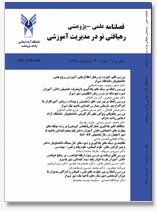رابطه سبکهای یادگیری با غلبه طرفی مغز دانشجویان بمنظوراستفاده در طراحیهای آموزشی
محورهای موضوعی : آموزش و پرورش
مرضیه امینی
1
*
,
احمد علی پور
2
,
بهمن زند
3
![]() ,
عیسی ابراهیم زاده
4
,
مهران فرج الهی
5
,
عیسی ابراهیم زاده
4
,
مهران فرج الهی
5
1 - عضو هیئت علمی دانشگاه آزاد اسلامی، واحد مرودشت، مرودشت، ایران
2 - - استاد دانشگاه پیام نور
3 - - دانشیار دانشگاه پیام نور
4 - - دانشیار دانشگاه پیام نور
5 - استادیار دانشگاه پیام نور
کلید واژه: لبه طرفی مغز, شیوههای درک, شیوههای پردازش داده ها, سبک همگر, سبک واگرا,
چکیده مقاله :
مهمترین هدف این پژوهش مطالعه و بررسی عوامل مرتبط با توفیق یادگیری دانشجویان مهندسی و پزشکی بود. به همین منظور، دو عامل سبک های یادگیری و غلبه طرفی (برتری نیمکره های مغزی) در دانشجویان دختر و پسر دراین دو رشته تحصیلی مورد بررسی قرار گرفت. مطالعه ازنوع همبستگی بوده و پژوهشگر به مقایسه 178 نفر ازکل دانشجویان دختر و پسر مشغول 89 رشتههای پزشکی و مهندسی دو دانشگاه شیراز و علوم - به تحصیل در نیمسال نخست 88 پزشکی شیراز پرداخت. در این پژوهش از شیوه نمونه گیری خوشه ای استفاده شد و دانشجویان دو پرسشنامه استانداردِ سبک های یادگیری کُلب و غلبه طرفی مغز سیلبر را تکمیل نمودند. تحلیل SPSS وآزمون خی دو و با بکارگیری نرم افزار 17 t آماری داده ها با استفاده از آمار توصیفی، آزمون صورت گرفت. نتایج بدست آمده از این پژوهش حاکی از آن است که دانشجویان دو رشته مهندسی و پزشکی از لحاظ شیوههای درک و پردازش داده ها با یکدیگر تفاوت دارند. همچنین، یافتههای مربوط به سبکهای یادگیری نشان دادند که دانشجویان رشته پزشکی بیشتر از سبک واگرا استفاده می کنند در حالی که دانشجویان رشته مهندسی گرایش بیشتری به سبک همگرا دارند. همچنین، در مقایسه شیوه های یادگیری دختران و پسران دانشجو نتایج نشان دادند که دختران شیوه تجربه عینی را بیشتر بکار میگیرند. در ارتباط با غلبه طرفی مغز بیشتر دانشجویان هر دو رشته تحصیلی از هر دو نیمکره مغز برای درک و پردازش اطلاعات استفاده می نمایند. همچنین، یافتهها حاکی از رابطه بین سبک یادگیری و غلبه طرفی، جنسیت و رشته تحصیلی میباشد
The main goal of the present research was to investigate factors related to learning success of medical and engineering students. In this regard, two factors, i.e. learning styles and hemispheric dominance of male and female students in these two majors were studied. The study had a comparative nature; for that reason, one hundred and seventy eight medical and engineering students of Shiraz University and Shiraz School of Medical Sciences studying in the first semester of 1388-1389 were compared with each other regarding their learning styles and hemispheric dominances. In this study, cluster sampling was employed to select the participants; then, the selected students completed two standard questionnaires, that is, Kolb’s Learning Style Inventory (1985a) and Silber’s Hemispheric Dominance questionnaire. Statistical analyses (descriptive statistics, t-test, and chi-square) were performed using SPSS software (17th version). Findings of the current study indicate that medical and engineering students are different from each other regarding their methods in perceiving and processing information. With regard to findings of learning styles, it was revealed that medical students mostly used divergent learning style while engineering students were more inclined to employ convergent learning style. Moreover, male and female students were compared regarding their learning styles. This indicated that females utilized concrete experimentation more than males. As regards brain hemispheric dominance, it was observed that most students in the two majors employed both hemispheres of their brains in perceiving and processing information. Besides, the results depicted an association among students’ learning style, hemispheric dominance, gender, and field of study

